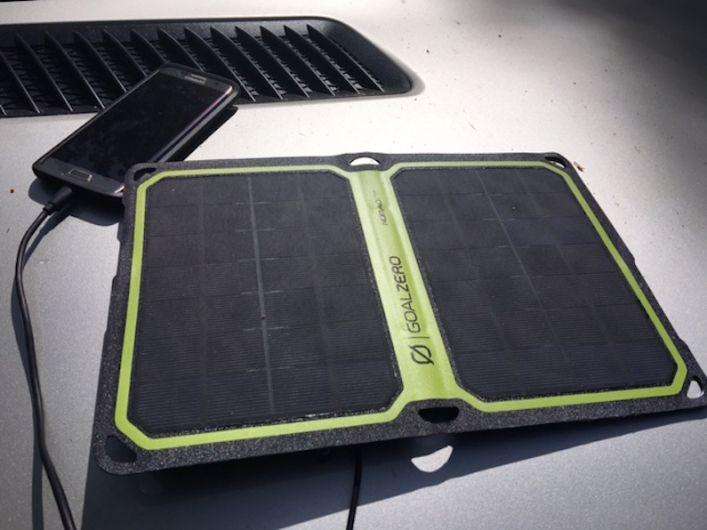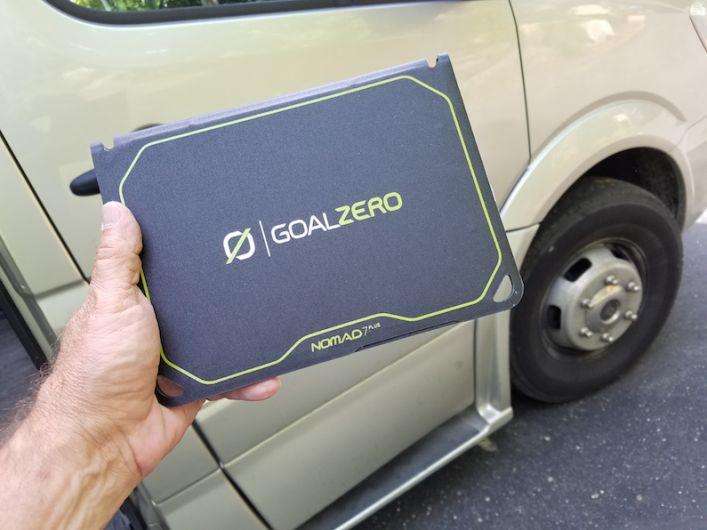New gadget: Portable solar charger

They say the most important piece of gear you can take on wilderness hikes these days is your cell phone.
I did an interview on the podcast some months back with a young woman who fell off a cliff and was rescued only because she could get an emergency call out with her phone.
So that's why I've added the Goal Zero Nomad 7 Plus Solar Charger to my backback. I've read about it on some of the outdoor forums I read and noticed a lot of buzz about how well and fast it worked. So I ordered one from Amazon.
At $99, it is not a cheapie charger. But that's okay. Reliability is what I was after. It folds up into a neat little package that fits into a daypack , measuring 6.5 by 8.75 inches, about .75 inches thick. To begin charging, unfold it to its 13.5 inch length, use the built in kickstand to get the best angle with the sun and it immediately starts converting sunlight into electricity that can charge your device.
 As soon as mine arrived, I put it o the front of the Roadtrek and plugged in my Samsung Galaxy 7 Edge smartphone. It had about a 73% charge when I plugged it in. An hour and a half later, it was topped off to 100%. There's a little zipper pocket on the device that has a female USB connector. So use whatever smartphone charging cable you have. It supposedly will charge a dead phone in about 4 hours.
As soon as mine arrived, I put it o the front of the Roadtrek and plugged in my Samsung Galaxy 7 Edge smartphone. It had about a 73% charge when I plugged it in. An hour and a half later, it was topped off to 100%. There's a little zipper pocket on the device that has a female USB connector. So use whatever smartphone charging cable you have. It supposedly will charge a dead phone in about 4 hours.
The smartphone is about the limit f what it can charge directly. But it can also charge small USB devices like cameras, headlamps or MP3 players. They require 1-2.5W of constant power to charge. The Nomad 7 panels can easily provide this amount of power even in sub-ideal conditions.
Smartphones and tablets are a bit trickier. They have a higher power requirement, usually around 5W of constant power. The Nomad 7 is rated at 7W but will only produce 5W at 1.4 amps in perfect sun conditions. And because smartphones are quite picky about their power requirements, they can “give up” charging if there is ever an interruption in constant power – like when a cloud passes by overhead.
You can easily see how efficient it is by illuminated dots on the power connector that indicate charge output strength. Four lights indicate maximum charging. When I first set mine up it showed three but I fiddled with thek ickstand and got a better angle to the sun and it went to four.
These panels just make electricity, that goes into your device. They don't store it. So it needs to be used “live,” so to speak.
A lot of people use the Nomad 7 to charge a battery pack. The company makes several different kinds. I have a Mophie Powerpack, which has a USB cable and works fine. The battery pack stores electricity so you could leave the Nomad 7 open and charging the battery pack during the day at camp and then use it to charge other devices. I don't usually need such a setup at camp because, even when boondocking, my Roadtrek CS Adventurous XL has 650 watts of its own solar power and banks of lithium ion batteries. It's pretty much energy independent.
I got the Nomad 7 is to have with me as an emergency way to keep my smartphone working should I ever get stranded or need communications while out hiking and away from camp.
And for that, the Nomad 7 is a welcome addition to my gearbag.
